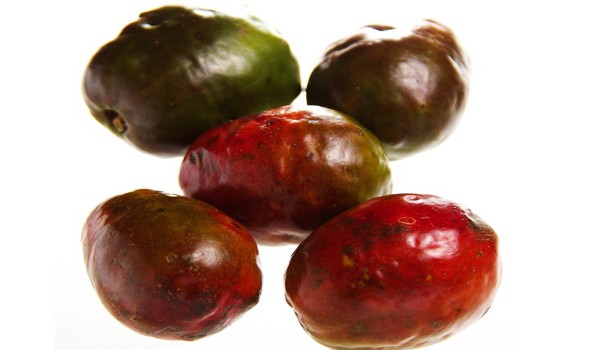- Overview
Common name: Mombin, Hog Plum, Ciruela, Jocote Botanical name: Spondias purpurea Family: Anacardiaceae Origin Central America Avg. Height X Width: 15' X 15' Season: May to July . Damage temp: 27 F Mombin/Hogplum/Jocote Tree Red Fruit in a 3 Gallon Container. The trees go dormant in the winter and drop all of their leaves. As spring begins to break the trees begin to flower, and the fruit follows in 45-60 days. The fruit and flower of the hog plum occur right on the branches as opposed to hanging from the tips. They are usually eaten as fresh fruit or pickled green and eaten in East Indian cooking. The fruit are sweet unlike store bought plums.
Description
Origin and Distribution
Varieties
Climate
Soil
Propagation and Culture
Season
Pests and Diseases
Food Uses
Food Value
Toxicity
Other Uses
Medicinal UsesOne of the most popular small fruits of the American tropics, the purple mombin, Spondias Purpurea L., has acquired many other colloquial names: in English, red mombin, Spanish plum, hog plum, scarlet plum; purple plum in the Virgin Islands; Jamaica plum in Trinidad; Chile plum in Barbados; wild plum in Costa Rica and Panama; red plum, as well as noba and makka pruim in the Netherlands Antilles. Spanish names include: ajuela ciruela; chiabal; cirguelo; ciruela; ciruela agria; ciruela calentana; ciruela campechana; ciruela colorada; ciruela de coyote; ciruela de hueso; ciruela del país; ciruela de Mexico; ciruela morada; ciruela roja; ciruela sanjuanera; hobo; hobo colorado; ismoyo; jobillo; jobito; jobo; jobo colorado; jobo francés; jocote; jocote agrio; jocote amarillo (yellow form); jocote común; jocote de corona; jocote de iguana; jocote iguanero; jocote tronador; jocotillo; pitarillo; sineguelas (Philippines); sismoyo. In Portuguese, it is called ambu; ambuzeiro; ameixa da Espanha; cajá vermelha (yellow form); ciriguela; ciroela; imbu; imbuzeiro; umbu, or umbuzeiro. In French, it is cirouelle, mombin rouge, prune du Chili, prune d'Espagne, prune jaune (yellow form) or prune rouge.
Description
The purple mombin may be a shrub or low-branched small tree in lowlands, or a spreading, thick-trunked tree reaching 25 or even 50 ft (7.5-15 m) in highlands. The branches are thickish and brittle. The deciduous, alternate, compound leaves bright-red or purple when young; 4 3/4 to 10 in (12-25 cm) long when mature; have 5 to 19 nearly sessile, obovate to lanceolate or oblong-elliptic leaflets 3/4 to 1 1/2 in (2-4 cm) long; oblique toward the base and faintly toothed toward the apex. The tiny, 4- to 5-petalled flowers, male, female and bisexual, are red or purple and borne in short, hairy panicles along the branches before the leaves appear. Somewhat plumlike, the fruits, borne singly or in groups of 2 or 3, may be purple, dark- or bright-red, orange, yellow, or red-and-yellow. They vary from 1 to 2 in (2.5-5 cm) in length and may be oblong, oval, obovoid or pear-shaped, with small indentations and often a knob at the apex. The skin is glossy and firm; the flesh aromatic, yellow, fibrous, very juicy, with a rich, plum-like, subacid to acid flavor, sometimes a trifle turpentiney; and it adheres to the rough, fibrous, hard, oblong, knobby, thick, pale stone, which is 1/2 to 3/4 in (1.25-2 cm) long and contains up to 5 small seeds.
Origin and Distribution
The purple mombin is native and common both wild and cultivated from southern Mexico through northern Peru and Brazil, particularly in and zones. There are some recent commercial plantings in Mexico and Venezuela. It is commonly planted in most of the islands of the West Indies and the Bahamas. Everywhere the fruits are sold along the roads and streets as well as in the native markets. Spanish explorers carried this species to the Philippines, where it has been widely adopted. The tree is naturalized throughout much of Nigeria and occasionally cultivated for its fruit. It has been infrequently planted in southern Florida, mainly as a curiosity.
rn
Varieties
The fruit is highly variable. The yellow form (uncommon) has been identified by some botanists as S. purpurea forma lutea F. & R., or even as a separate species, S. cirouella Tassac. It has been confused with the true yellow mombin, S. mombin L. (syn. S. lutea L.), q.v. In Guatemala, the variety called jocote de corona, which is flattened and somewhat shouldered at the apex, is said to be of superior quality, and jocote tronador is nearly its equal.
rn
Climate
The tree is tropical, ranging from sea-level to 5,500 or 6,000 ft (1,700-1,800 m) in Mexico and Central America; to 2,500 ft (760 m) in Jamaica, in either dry or humid regions. It flowers but does not fruit in Israel; is cold-sensitive in Florida.
Soil
The tree is found growing naturally on a great diversity of soils throughout Latin America-sand, gravel, heavy clay loam, or limestone.
Propagation and Culture
The purple mombin, including its yellow form, is grown very easily and quickly by setting large cuttings upright in the ground. It is one of the trees most used to create "living fences". It grows very slowly from seed.
Season
There are flowers and fruits of the red form nearly all year in Jamaica, but mainly in July and August, while the yellow variant fruits only from September to November. In the Bahamas, the fruiting season of the red type is brief, just May and June; the yellow ripens from August to early October.
Pests and Diseases
Fruit flies commonly infest the ripe fruits. In Florida, the foliage is subject to spot anthracnose caused by Sphaceloma spondiadis.
Food Uses
The ripe fruits are commonly eaten out-of-hand. While not of high quality, they are popular with people who have enjoyed them from childhood, and they serve a useful purpose in the absence of "snackbars". In the home, they are stewed whole, with sugar, and consumed as dessert. They can be preserved for future use merely by boiling and drying, which keeps them in good condition for several months. The strained juice of cooked fruits yields an excellent jelly and is also used for making wine and vinegar. It is a pleasant addition to other fruit beverages. In Mexico, unripe fruits are made into a tart, green sauce, or are pickled in vinegar and eaten with salt and chili peppers. The new shoots and leaves are acid and eaten raw or cooked as greens in northern Central America.
Food Value Per 100 g of Edible Portion (Flesh)*
Moisture 65.9-86.6 g
Protein 0.096-0.261 g
Fat 0.03-0.17 g
Fiber 0.2-0.6 g
Ash 0.47-1.13 g
Calcium 6.1-23.9 mg
Phosphorus 31.5-55.7 mg
Iron 0.09-1.22 mg
Carotene 0.004-0.089 mg
Thiamine 0.033-0.103 mg
Riboflavin 0.014-0.049 mg
Niacin 0.540-1.770 mg
Ascorbic Acid 26.4-73.0 mg
Amino Acids** (mg per g nitrogen [N = 6.25])
Lysine 316 mg
Methionine 178 mg
Threonine 219 mg
Tryptophan 57 mg
*Analyses made in Central America and Ecuador.
**Brazilian analyses.
Toxicity
In the Philippines, it is said that eating a large quantity of the fruits on an empty stomach may cause stomachache.
Other Uses
Gum: The tree exudes a gum that has served in Central America as a glue.
Wood: The wood is light and soft; has been found to be suitable for paper pulp in Brazil. It is sometimes burned to ashes which are employed in making soap.
Leaves and fruits: The leaves are readily grazed by cattle and the fruits are fed to hogs.
Lac: Lac insects have been raised on the red mombin in Mexico.
Medicinal Uses
In Mexico, the fruits are regarded as diuretic and antispasmodic. The fruit decoction is used to bathe wounds and heal sores in the mouth. A sirup prepared from the fruit is taken to overcome chronic diarrhea. The astringent bark decoction is a remedy for mange, ulcers, dysentery and for bloating caused by intestinal gas in infants. In the Philippines, the sap of the bark is used to treat stomatitis in infants. The juice of the fresh leaves is a remedy for thrush. A decoction of the leaves and bark is employed as a febrifuge. In southwestern Nigeria, an infusion of shredded leaves is valued for washing cuts, sores and burns. Researchers at the University of Ife have found that an aqueous extract of the leaves has antibacterial action, and an alcoholic extract is even more effective. The gum-resin of the tree is blended with pineapple or soursop juice for treating jaundice. Most of the other uses indicate that the fruits, leaves and bark are fairly rich in tannin. - Features
weight: 9.99 lbs : - Reviews11 review for Mombin/Hogplum/Jocote/Ciruela RED Fruit Tree
Read all 1 review on Mombin/Hogplum/Jocote/Ciruela RED Fruit Tree




This tree is massive when it arrived. I ordered 6 trees and this was the largest. Two very large trunks in a v-shape. Leaves are healthy and plentiful. I live in AZ and had heard another person have trouble with leaf drop due to our dryness, so I put it next to a cool humidifier for now. Only a few leaves have dropped but tree is doing very well.